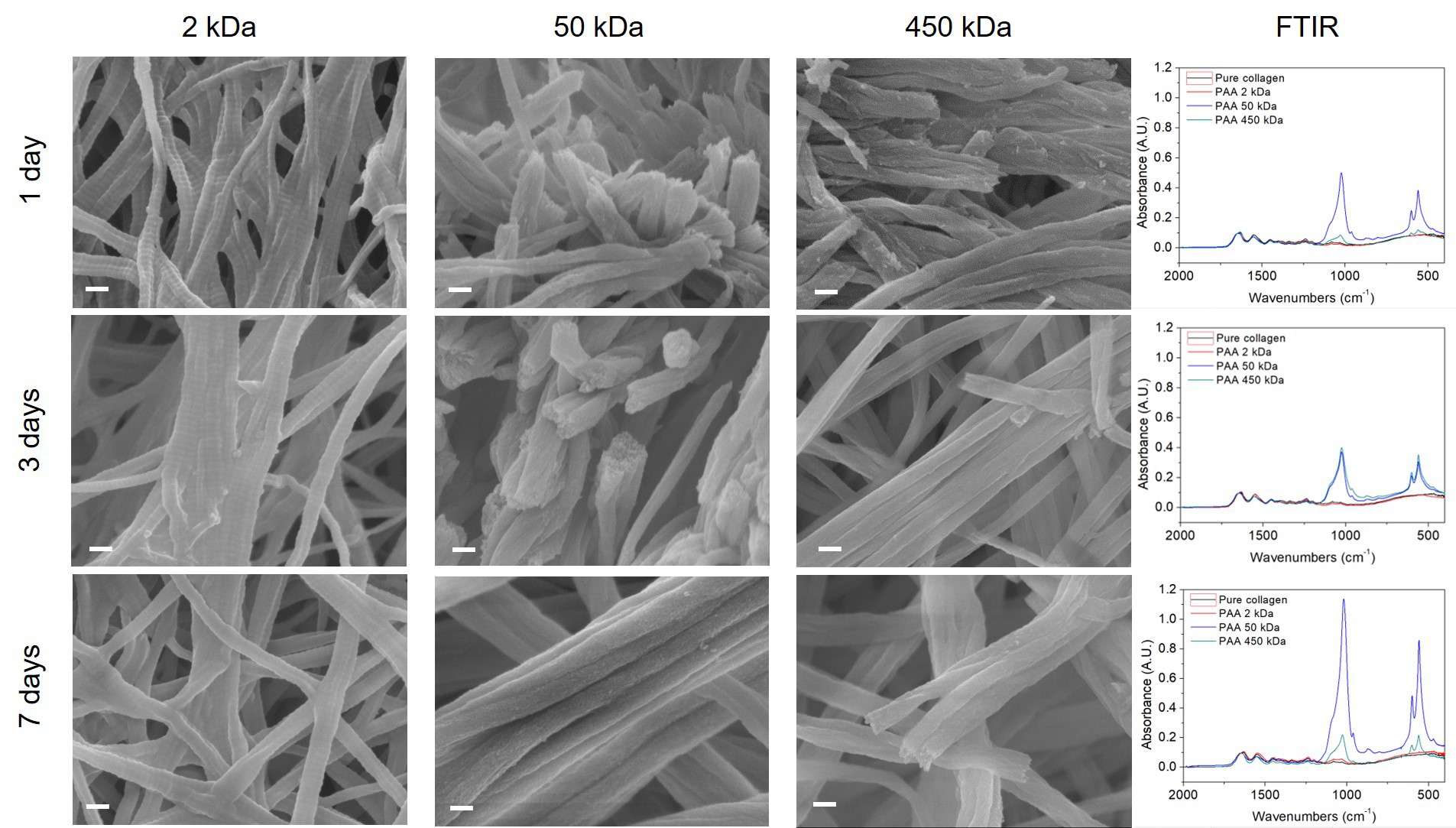IADR Abstract Archives
Optimizing PAA Molecular Weight in PAA-ACP Solutions for Developing Bone-like Nanocomposites
Objectives: Intrafibrillar mineralization of collagen fibrils can be achieved using polyelectrolytes, such as polyacrylic acid (PAA), as analogs for non-collagenous proteins. We aimed to optimize the molecular weight (MW) of PAA at 50 mg/L as mineralization-directing agent for developing optimal bone-like nanocomposites.
Methods: Optical-density profiles of the PAA-stabilized amorphous calcium-phosphate (PAA-ACP) solutions containing increasing MWs of PAA (2, 50, 450 kDa, 50 mg/L) and 4.5-mM CaCl2, 2.1-mM K2HPO4 were determined. Before precipitation, PAA-ACP particles were characterized for size and charge using dynamic light scattering (DLS) and zeta potential, respectively. Crosslinked reconstituted type I collagen films were mineralized in PAA-ACP solutions for 1, 3 and 7 days, and characterized by scanning electron microscopy (SEM), energy dispersive X-ray spectroscopy (EDS) and attenuated total-reflectance Fourier-transform infrared spectroscopy (ATR-FTIR). During mineralization process, PAA-ACP solutions were replaced every 3 days.
Results: PAA-ACP solutions of PAA 2 kDa and 50 kDa stayed clear after 7 days, whereas 450-kDa solution precipitated after 2 days. PAA-ACP particles had hydrodynamic diameter under detection limit in 2-kDa PAA-ACP solution, whereas in 50-kDa and 450-kDa solutions, the particle size increased within 48 hours. The zeta potential of all solutions was approx. -24 mV. Intrafibrillar mineralization in collagen fibrils started on day 1 in 50-kDa and 450-kDa PAA solutions and progressed to form bone-like nanostructures. ATR-FTIR confirmed the appearance of apatite minerals. However, neither intra- nor extrafibrillar mineralization was detected in collagen placed for 7 days in 2-kDa PAA-ACP solution.
Conclusions: This study showed a faster particle growth rate and more efficient intrafibrillar mineralization of reconstituted collagen as PAA MW in PAA-ACP solutions increased. Densified type-I collagen films were mineralized in PAA-ACP solutions containing PAA of 50 kDa and 450 kDa, producing collagen matrices with potential for hard tissue engineering applications as they resembled the ultrastructure of bone.
Methods: Optical-density profiles of the PAA-stabilized amorphous calcium-phosphate (PAA-ACP) solutions containing increasing MWs of PAA (2, 50, 450 kDa, 50 mg/L) and 4.5-mM CaCl2, 2.1-mM K2HPO4 were determined. Before precipitation, PAA-ACP particles were characterized for size and charge using dynamic light scattering (DLS) and zeta potential, respectively. Crosslinked reconstituted type I collagen films were mineralized in PAA-ACP solutions for 1, 3 and 7 days, and characterized by scanning electron microscopy (SEM), energy dispersive X-ray spectroscopy (EDS) and attenuated total-reflectance Fourier-transform infrared spectroscopy (ATR-FTIR). During mineralization process, PAA-ACP solutions were replaced every 3 days.
Results: PAA-ACP solutions of PAA 2 kDa and 50 kDa stayed clear after 7 days, whereas 450-kDa solution precipitated after 2 days. PAA-ACP particles had hydrodynamic diameter under detection limit in 2-kDa PAA-ACP solution, whereas in 50-kDa and 450-kDa solutions, the particle size increased within 48 hours. The zeta potential of all solutions was approx. -24 mV. Intrafibrillar mineralization in collagen fibrils started on day 1 in 50-kDa and 450-kDa PAA solutions and progressed to form bone-like nanostructures. ATR-FTIR confirmed the appearance of apatite minerals. However, neither intra- nor extrafibrillar mineralization was detected in collagen placed for 7 days in 2-kDa PAA-ACP solution.
Conclusions: This study showed a faster particle growth rate and more efficient intrafibrillar mineralization of reconstituted collagen as PAA MW in PAA-ACP solutions increased. Densified type-I collagen films were mineralized in PAA-ACP solutions containing PAA of 50 kDa and 450 kDa, producing collagen matrices with potential for hard tissue engineering applications as they resembled the ultrastructure of bone.

